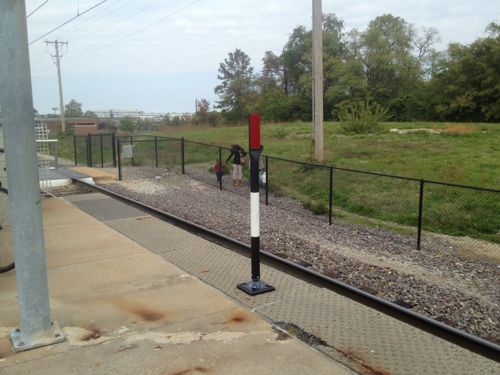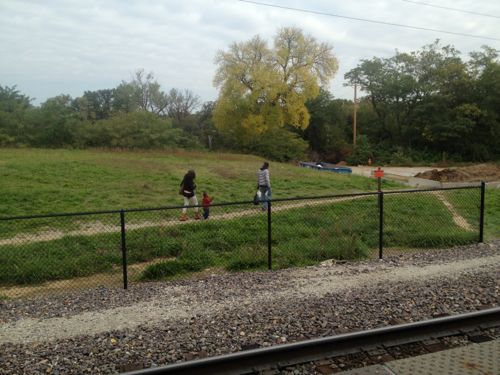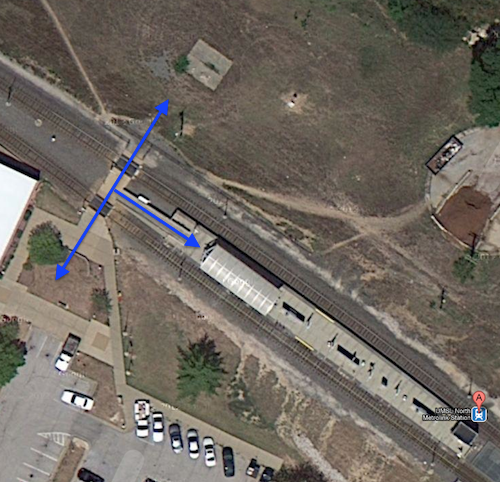Potential Of UMSL North MetroLink Station
Yesterday I took a detailed look at Developing The North Hanley MetroLink Station, today I’ll briefly look at the next station on the line: UMSL North.


Like other stations, this has been in use for over 19 years now. The campus side of the station wasn’t designed for pedestrians and the other side has been ignored.

I’m not optimistic about how this area will get developed, when it does eventually. I’m afraid it’ll end up like other stations — very auto-centric rather than being pedestrian-centric. The potential is enormous.
— Steve Patterson
I’m not seeing the potential. Everything to the immediate west of this station is already auto centric. UMSL, like other “new” universities has been designed around vehicle access and accommodation (sprawling so much it requires 2 LRT stops). The potential vacant development land to the north of the station is likely being held by UMSL for future academic expansion (rather than transit oriented development) and, if they follow their past development, it will be very low density. The south station potential is even worse with no vacant land near by. Additionally the surrounding neighborhoods are largely golf courses and cemeteries, leaving ridership nearly exclusively all University students.
I want transit oriented development for the St. Louis LRT as much as the next guy but given the path the lines take not all stations have what it takes, especially not in a recession.
Another large road block for these “north” stations is their general location in the metro area itself. Hanley Station’s location next to communities like Kinloch don’t exactly scream “awesome development location,” especially for housing. Additionally area residents are generally lower income and won’t be frequenting shops, purchasing gourmet coffee’s and sandwiches on the way to/from work every day.
At least that’s how I’d see it if someone wanted my millions to develop there.
This station, like the Hanley Road Station is a dying planning model that is based solely on automobile traffic. The huge parking lot at Hanley represents people willing to take transit, yet the city planning/ transit system failure is so enormous it requires.a massive parking garage and lot to compensate for mediocre transit planning.
(Note, the preferably of a short distance walking to transit is true, my experience is that longer walking distances become more acceptable if they are occasional and part of an efficient, quick transit system)
Cities I have been in with successful transit would greet passengers with capitalism. In other words an array of stores, vendors and so on. Certainly the volume of Hanley Road should warrant such commercial activity.
Build a plaza connected to the station, invite daily or weekly markets. There is a lot more economic growth possible than with the people currently running things have managed to accomplish.
Trust me there are small time capitalists who could make a living at especially the Hanley Road site. However they are not big time developers that will develop the site, nor that will charge big time rents.
The failure here is totally on government management. At a minimum many of the light rail stops should have plazas where economic activity can occur. The government needs to take the lead. The free market system does not solve all problems. Here is a clear case for government involvement. Plazas are the cheapest thing to do in the public interest.
In some cases the urban planning is so screwed up, as on the university site and many others, even plazas might not help. It could have worked with some forethought, but after the fact is hard, the main problem with the efforts of the CMT group.
More importantly, why in the hell is this group not advocating for a transit centric plan surrounding the Grand Ave Station if they want to be useful? This site is begging for direction and it wouldn’t be completely after the fact like the Hanley Road or University Station. It’s ridiculous.
Silence on Biondi, silence on SLU, silence on the lack of City of St. Louis action to insure the public investment of this site is protected. Silence, that’s all I hear.
One, providing parking is a good solution to that “last mile” conundrum that our modern planning creates. By creating a dense community of vehicles, even if we can’t / choose not to create dense residential, commercial or employment centers, we create the density of riders that transit needs to provide more-frequent service and, in turn, make transit more attractive to commuters. Remember, public transit’s primary mission is to move people, not to be a leader in urban planning. The “government” that dropped the ball here is UMSL and the surrounding small cities, who have done little to densify development at and around the station areas.
Two, while I understand your frustration with the Grand Station, the fundamental issue there is the choice to use/stay on the rail corridor, 2 stories under the viaduct. It creates a situation where any potential retailer needs to pick between two bad options, locating at platform level (with parking, but hard to reach by driving) or at street level (lots of traffic, but horrible/no parking options). (And no, relying solely on transferring transit riders is NOT a viable business model, you need non-riders, as well, like the occupants of adjacent residential, office and educational uses, of which there are few here.) The current station “works”, as well as it can, for riders wanting to transfer, but would’ve worked much, much better, for ancillary development, if the light rail line had been routed down the center of Forest Park Parkway or, even better, down Laclede Avenue, at grade.
Transit is in fact a leader, it helps determine the shapes and forms of communities as does walking and bicycles. The problem is almost everything is designed for the auto.
Nor is it reasonable for small cities to all make urban planning decisions for a regional transit system. That is supposed to be why the East West Gateway Council is supposed to be in existence, for regional guidance in transportation and other issues.
They are not doing their job.
As far as station at Grand Ave, you give a lot of reasons why things can’t work. I think you are completely wrong. Actually that is the point. There isn’t a discussion of the obvious potential of the Grand Ave station that is surrounded by a great deal of vacant land, underutilized buildings with multiple transit connections and even surrounded by an existing density even now.
Yet CMT, the Citizens for Modern Transit , goes out to the Hanley Road station which requires a complete makeover if it is to be anything close to a true transit station, this includes the need to intensify connections, plan for more density and so on. Nothing anyone seems to want to take on.
Meanwhile the Grand Avenue site is crying out for some kind of discussion, a policy structure for starters that prevents suburban style development near this station.
Otherwise why is the public spending money on expensive light rail and a pedestrian orientated bridge?
As the events of the last year have shown, the Grand Ave site is in flux and needs attention, The Hanley site isn’t going any where at this point.
I checked St. Louis County’s property data and all the vacant land north of the station is owned by the University of Missouri except for a few small parcels that are owned by Metro. UM seems to own almost all the land all the way up to highway 70, so there would be little opportunity for privately developed TOD here unless they gave up some of this land, which would seem unlikely. It would seem possible to do something as a public/private partnership if UM wanted to get creative.